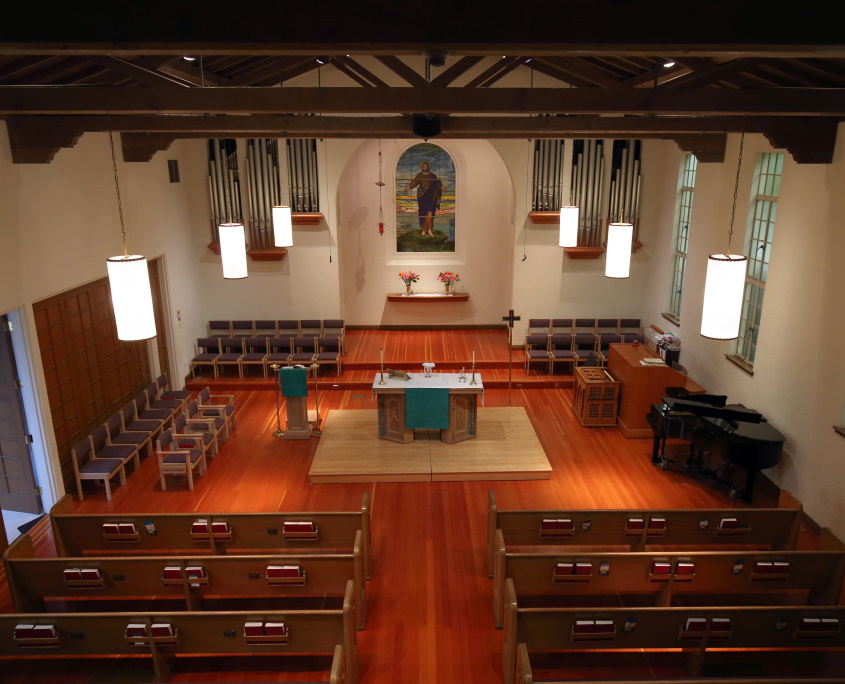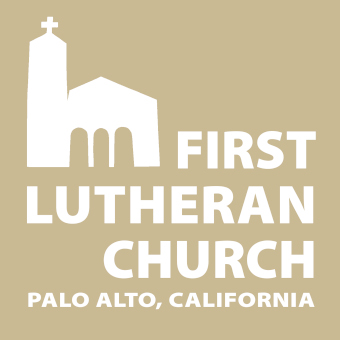Sunday Liturgy
Here’s a little guide to what we do in the sanctuary on a typical Sunday morning.

What’s going on when we gather on Sunday morning?
We’re used to calling it “worship,” but that means honoring God in all we do, 24/7. “Liturgy” is from a Greek word meaning a public work or service, having to do with order of the ritual. Lutherans have called this ritual Divine Service and – from our Catholic origins – Mass (let’s call it Mass here, because it’s a short word). Sunday itself is a gift, known as the Lord’s Day and first day of the week. The pattern of what we do goes way back (see Acts 2:42-47). Lots goes on here, such as rest, learning, praise, giving and fellowship. But ultimately, what happens here is God’s doing: drawing us together around Jesus Christ and his promises.
Confession or Thanksgiving for Baptism
We begin at the water, the font. Baptism is about beginning. Each day we remember we’re claimed as God’s children and our sins are forgiven. All ages can be baptized; let us know if you’re curious about it.
The little red cross means to make the sign of a cross over your chest, shoulders and head as a way of internalizing that message. The confession of sins is one way we return to baptism to begin again. It’s a separate rite we undergo before the Mass; it used to be offered at a separate time before Sunday. We name our belonging to a world gone wrong and a people in dire need. But Lutherans don’t emphasize sincerity of confession so much as trust in the word of forgiveness.
Entrance or Gathering Song
As we trickle in and gather together, we sing. Lutherans encouraged everyone at Mass to sing (not just musicians or clergy). Luther said that music is a gift of God second only to God’s word, helping the singer feel the consolation and joy of God’s message: “it is the function of music to arouse the sad, sluggish and dull spirit” (even chants need not be sluggish). It’s very OK not to sing, and let other voices carry, or to go for it, even if you’re not sure it sounds great.
There are specific traditional hymns for the Western Mass, in use for many centuries: Glory to God (You alone are Lord … so, all those other powers and tyrants, aren’t), Kyrie (Lord have mercy), Credo (I believe …), Sanctus (Holy), Agnus Dei (Lamb of God) and others, some used seasonally. Repeating these week by week, we internalize them. Many hymns, such as in the red book, were originally used in home devotions, and only in recent centuries also sung at Mass.
Greeting, Prayer of the Day
This Greeting (from 2nd Corinthians 13) summarizes the message of the whole Service.
The Prayer of the Day (or Collect) draws on the particular themes in that day’s scripture readings, preparing us to listen but also to act on what we hear.
The Readings, Psalm
Multiple churches (such as Methodists and Episcopalians) have agreed to use the same three year cycle of readings known as the Revised Common Lectionary. Use of such lectionaries goes way back and challenges us to hear scripture we wouldn’t choose. The lectionary psalm is meant to follow the Old Testament reading that precedes it. The biblical book of Psalms is sort of our core prayer book and hymnal. Lectionary readings from the New Testament tend to carry us through the book, chapter by chapter.
Stand for the Gospel Acclamation
The basic posture for the Mass is to stand: ready for action – we’re not an audience, but participants. We stand as if to greet someone: the Risen Christ. Standing is also the traditional posture for liturgical prayer. We boldly ask for and expect God’s will to be done – sometimes with arms outstretched. This can be our attitude even if it’s difficult or impossible to stand physically.
This year the lectionary uses Luke; last year, Mark; next year, Matthew; all four years, John.
Sermon, Hymn of the Day, Creed
Each Sunday there’s a surplus: there’s stories, images and teachings – the Bible is big! (and even a three year cycle leaves lots out). In the sermon, we attempt to identify a theme that seems to resonate today: what is God’s will? What does God promise? At the table, we’ll hear Jesus say, “my body given for you, my blood shed for you.” The sermon intends to convey that same message of Jesus, just with more explanation (or, just more long-windedly?).
All the hymns and music are chosen to reinforce themes from that day’s scriptures, especially the Hymn of the Day. For Lutherans, texts matter!
During some seasons we also use a Creed, which tells of what God has done for us and how God loves us.
Prayers of Intercession
In response to what we heard God promise to us in the scripture and sermon, we ask for God to make good on these promises. We name before God the needs we see in our world.
These intercessions follow a weekly pattern: for the church, for the well-being of creation, for those who govern, for those who suffer need, for the congregation and those close to us – and often thanksgiving for the faithful departed.
You are welcome to add your own concerns to these prayers – it can be very simple, such as just a name.
Sharing of Peace (Transition towards the Table …)
We transition towards the table, to celebrate what’s known as the Lord’s Supper (1 Corinthians 11), or Eucharist (meaning Thanksgiving), or by other names …
Such as Holy Communion, since it’s about unity. One gift of this rite is to draw us together in communion / community as siblings in Christ. The sharing of peace is a time to reconcile before gathering around the table. (Matthew 5:23-24)
Quoting 1 Corinthians 10:17 “We are all one bread and one body, for we all partake of one bread and one cup” Luther said this communion is about sharing burdens, sufferings, sins, help, support, honor: “the sacrament has no blessing and significance unless love grows daily and so changes a person that he is made one with all others.” (A sacrament is a physical sign of an unseen promise – we recognize the sacraments of the altar (communion) and baptism.
Offering
And .. it’s about God’s provision for the hungry. Early Lutherans felt strongly that the Mass isn’t about anything we can offer to please or persuade God; it’s about everything God offers to us and the world, freely, without our deserving it.
These Lutherans would store goods and money at church to distribute to those in need. At the Lord’s Supper, Jesus invites us to share. In the hands of Jesus, a few loaves and fishes can feed thousands (Luke 9:10-17).
The Lord be with you. And also with you …
And it’s about being in the presence of God.Here we speak each other into the Lord’s presence, with hearts lifted up – meaning, we’re fully present to God, including thoughts, feelings, imagination.
These words (in Latin, Sursum Corda) have been used since the 3rd century (and even the tune is from way back).
It is indeed right … that we should give thanks and praise to you …
And it’s about thanksgiving … Earlier in the Mass we asked God for things; now we give thanks – following Jesus, who “took bread and gave thanks, broke and blessed …”
Specifically, we give thanks for the great acts of God which give us life and hope. “On this day” here refers to Sunday as the day of resurrection. These thanksgivings are tied into themes of the church seasons (so Christmas season has different wording than Easter season).
Holy, Holy, Holy Lord …
“Sanctus” in Latin, meaning “Holy,” invites us to cosmic unity of praise in the presence of God. Some people bow during the first half of the hymn – about God’s awesome, transcendent presence (it’s the song of Heavenly beings in Isaiah 6) – rising and making the sign of the cross during the second part of the hymn, a line from Psalm 118 (“Blessed is he …”) from when when Jesus rode his donkey into Jerusalem, where he would be crucified. From highest heaven to humblest depths: what a ride!
In the night in which he was betrayed … and prayers that follow.
A version of Jesus’ words at the Last Supper, found in the gospels and Paul (1 Corinthians 11). It’s “the gospel in nutshell” (M. Luther), succinctly stating the main message and gift of the Service as a whole.
Jesus said “do this in remembrance of me,” so we remember, then call out again for God to make good on God’s promises.
We don’t just ask for quick solutions or fixes or even answers to our prayer, we ask for and anticipate the great feast beyond imagining, heaven come to earth.
Our Father in heaven ….
We conclude our prayers by joining our voice with Jesus in the prayer he taught us.
Lamb of God, you take away …
The hymn Lamb of God (Latin: Agnus Dei) comes from John 1:29, also goes way back. It’s about being in the presence of Christ, who takes away not just my sin, but the world’s sin.
Invitation to Communion
We’re invited to trust Jesus when he says, “this is my body,” and blood (he’s really present) and the personalized “given for you” and “shed for you.” It’s for me, in particular. As we share the meal, already Jesus’ prayer “Our Father” is being answered: God’s kingdom is here (as we share God’s gifts), we are being given our daily bread, our sins are right now forgiven as we have reconciled with people around us, and we’re being delivered from evil.
Post-Communion Prayer, Announcements, Benediction
The Mass doesn’t end with a conclusion; it continues with the Sending: now, we go out to celebrate the Lord’s Day in fellowship (such as the reception or Sunday festivities at home), love of neighbor, and renewed hope.
Explanations by Pastor Bernt. Some of the sources used include: Frank Senn, “An Introduction to Christian Liturgy.” Martin Luther, “The Blessed Sacrament of the Holy and True Body and Blood of Christ, and the Brotherhoods” (1519). Gordon Lathrop, “Central Things: Worship in Word and Sacrament.” Robin Leaver, “Luther’s Liturgical Music: Principles and Implications.” And: various official ELCA worship resources.
